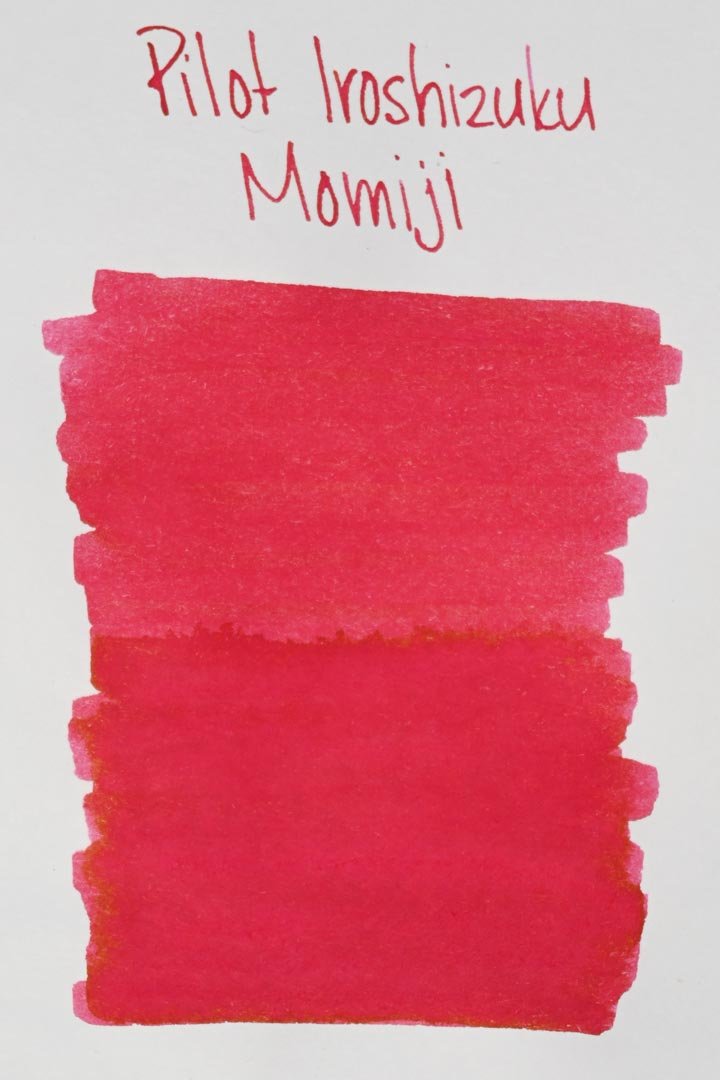Pilot Iroshizuku Momiji
Ink Review #22
*Please note that the scan is the accurate representation of this color.
Overview
The color/properties:
Momiji is a vibrant pink-red. To my eye, it leans more pink, especially in good lighting. In both print and cursive, it shades with a soft gradient between its base color and a fuller, redder tone where the ink pools.
The ink also has a slight golden sheen. The degree of sheen you get will vary between the pen and paper used, but it’s never a solid layer of sheen. Rather, it looks more like golden specks throughout the writing, and at most a thin film of gold that you can still see the base color through. I wouldn’t call it a dull sheen, but I wouldn’t call it reflective either. It’s not always the easiest to see, but in my experience, it’s the combination of the sheen and the base color that brings out the red tones of this ink.
Ink splat
Ink droplets
Rhodia
Leuchtturm1917
Performance on paper:
Momiji mostly performed well, there was some typical bleed-through with larger nib sizes in the Kokuyo notebook, and I didn’t experience any bleeding or feathering on most of the others, but surprisingly I did notice some micro feathering in the Leuchtturm notebook.
The dry times were slightly below average: most of the nibs dried within 20 seconds, but there were a couple of instances where the ink took 25 or more, and in some cases failed to dry within the 30-second mark.
There was some water resistance, but the water creates pink, hazy clouds of color that can make the writing difficult to read. Using this ink with a wetter pen will more than likely exacerbate this problem.
Midori MD
Maruman
Tomoe River
Kokuyo
Water resistance
Chromatography
Performance in the pen:
Momiji mostly performed well, but not without issues. The ink generally has a medium flow, and when it’s working well, the lubrication is excellent and the writing experience is enjoyable. However, the flow isn’t always the most consistent. While using the needlepoint, I encountered a lot of skipping and dry writing. In contrast, the broad nib was notably wetter than normal (far more than it should be based on my other tests). On the other hand, the broad nib I used for the writing samples (Pilot Vanishing Point) flowed just fine, and despite some inconsistencies in flow, I didn’t encounter any other hard starts or skipping beyond the needlepoint. Generally, the ink should be a great experience.
Though I haven’t encountered it myself, it wouldn’t surprise me if Momiji’s high saturation caused the ink to form layers of crust around the nib. This isn’t a big deal, and it can be easily wiped off, but it’s worth mentioning.
Cleaning this ink out was easier than anticipated (again, due to the high saturation). It only took 2 sets of soaking in flushing to clear the color from the test nibs, but unfortunately, there was residue staining where the section and barrel of the pen connect to each other, which required some extra effort to clean. Thankfully, it didn’t require disassembly of the pen, but I would be wary of using this ink with pens that might be easily stained.
Written on 52 gsm Tomoe River paper (white) with a medium nib.
Written on Midori MD paper (cream) with a medium nib.
While testing this ink on Cosmo Air Light paper (with a fine nib), it showed a very bright sheen, though you can see it’s still not quite the full layer of sheen that you would find in a conventional sheening ink.
Performance in a pen: 8.5/10
Performance on paper: 8.5/10
Color saturation: 8/10
Sheening: 4/10
Shading: 2/10
Dry time: 6.5/10
Water resistance: 2/10
Ease of cleaning: 5.5/10
Shimmer: None
My personal thoughts…
Momiji is a word for autumn leaves — specifically the pinkish-red leaves of maple trees in the fall. I think the effect was done quite well, not just in the base color but in the slight golden sheen that specks through the ink as you write with it. It’s not sheen as most might expect — I imagine that this ink would sooner bleed through the paper than actually sheen in the conventional sense — but picture the slight sparkle that you might see on some rocks from the mica minerals. That’s what it looks like, and it imparts this ink with a very natural and earthy appearance. I have no idea if that was Pilot’s intention, but I’d like to imagine it was.
Written on 52 gsm Tomoe River paper with a Pilot Vanishing Point (broad nib).
More images/info:
Tools and materials used in the writing samples:
A TWSBI Diamond 580 AL with 7 nib units including a Needlepoint grind, EF, F, M, B, 1.1mm stub, and an Architect grind. All nibs are tuned to perform at the same medium wetness.
A Rhodia No16 A5 DotPad
A Leuchtturm1917 A5 Notebook
A Midori MD A5 Notebook
A 68gsm A5 Tomoe River Notebook
A Maruman Mnemosyne A5 Spiral Notebook
A Kokuyo Campus A5 Notebook


















